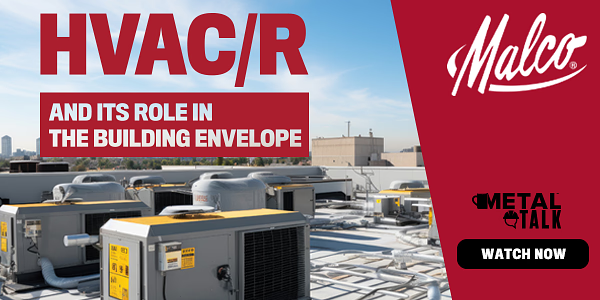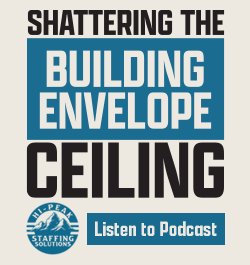Growing Your Business with Gutters - PODCAST TRANSCRIPT
July 23, 2025 at 11:00 a.m.Editor's note: The following is the transcript of a live interview with Tim MacVeigh with Tru-Seam Metal Solutions. You can read the interview below, listen to the podcast or watch the recording.
Intro: Hello and welcome to MetalTalk from MetalCoffeeShop. My name is Heidi Ellsworth and we have a fantastic MetalTalk for you today. It is all about gutters. But before we get started, let's do a little bit of housekeeping.
This is being recorded and it will be available on demand within 24 to 48 hours. And of course, as always, our chat is open, so please ask questions, make comments, let us know what you're thinking because we are ready for those questions. We've got a great, great speaker today and I am very happy to introduce Tim MacVeigh of Marsh Building Products, but of SRS. So Tim, welcome to the show.
Tim MacVeigh: Well, thank you very much, Heidi. I'm glad to be here.
Heidi Ellsworth: Tim, can you tell us a little bit about you, your history and about your company?
Tim MacVeigh: Well, sure. So as you said, my name is Tim MacVeigh and I work for SRS Building Products. Formerly was known as Tru-Seam Metal Solutions as part of the Marsh Building Products Group. Been in the building products distribution business for about the last 36 years.
Heidi Ellsworth: Wow.
Tim MacVeigh: And that was whether it be shingles, whether it was windows, siding, did a lot of different things. And about 12 years ago, we got really into the gutter business and began to see where that had just a tremendous opportunity. And it began to grow and grow pretty quickly. It actually was one of our fastest growing segments of our business and we began to invest in it. And what I mean by that is you used to be able to get white or white or you could get, then it became white and about three different colors. And the owners of Marsh Building Products, very much entrepreneurial, invested in metal and paint and began to paint coil to match all the different soffit colors that were out there.
Heidi Ellsworth: Nice.
Tim MacVeigh: That quickly got us into the business and we began to source materials, color match material. The perfect match was born. And the gutter grew to the point where we decided we would start to manufacture. So again, I got into the manufacturing end just by happenstance, I had no formal background in manufacturing. And we've been doing that since about 2013. It's grown tremendously and what we've done is we're able to now vertically integrate. And it made Marsh very successful and one of the reasons that in 2023 they were acquired by SRS Distribution.
And a little different for SRS because they're [inaudible 00:03:21] shingles and roofing and we were doing gutters and some other things. And we're just starting to now, it's been a couple of years ago, so we're just starting now to kind of grow and begin to take on some other branches.
In there, I have to add that in 2024, SRS was acquired by The Home Depot. So been a couple of changes from a family owned to a big company to a ginormous company. But so far, it's been a good ride and it's put me in a position where I live and breathe the gutter business every day.
Heidi Ellsworth: And it's such an important part of the building envelope, the structure, everything that goes along with that to really protect the home, protect the building. So I do want to remind everyone that the chat is open. Please let us know who you are, where you're calling from, what you're doing. We are excited to hear from you. And we're going to get started right along these lines.
So Tim, just what you were talking about, let's start with why should contractors add gutters to their offerings for their business?
Tim MacVeigh: So kind of two different schools of thought there, the same and different. But for your roofers, to me, if you're doing roofing and you're not doing gutters, I would just be shocked because they just go hand in hand. When you put on a roof, you're going to put on drip edge. You're going to put on facia, the rake edge, whatever you're going to do. Gutters just goes right along with that.
And if you're a remodeler, again, a lot of times when you're tearing off or you're remodeling, you need to replace that gutter anyway. Why not make it a one-stop shop? Why not have, be able to wrap the package completely?
And there's some ways that you can get into that, if you're not into it, that are really pretty low impact, all the way up to getting your crews more involved. But the nice thing about gutter, it's not a huge... It's about a 30% add to a roof job. But the margins are high. You're not going to get hurt by it. And again, you're creating a one-stop shop that you're going to do the complete job whether you do it or whether you sub out the gutter.
Heidi Ellsworth: Yeah. And really, when you're looking at that and I know we're going to talk a little bit more about this later, but that bundling of services really does make a big difference. When you can talk to a homeowner and say, "Well, we can do your roof, we can do your windows, we can do your siding, we can do your gutters," it makes a difference because that one-time customer now becomes a long-term customer.
Tim MacVeigh: That's correct. And you're also, you're moving from in the sales end of it, you're moving into consultative sales. So you're consulting with a customer, you're offering choices of, again, as we talked about, it's not just white or white, it's now we can match colors, we can accent colors, whether it be matching the soffit, matching the roof, whatever it might be. But it's beyond just selling a roof or a siding job, now it's consultative. It's saying, "Hey, let's do this." And there's some companies have programs now where you can add those colors on a computer, so you can digitally see what that job is going to look like even before they begin.
Heidi Ellsworth: Well and I love that, what you're talking about being consultative because when you were sitting there, let's just say with a homeowner, but this works with a building owner too, but as you're sitting there and after you've done the inspection, if you're able to offer all of these things, but especially roofing and gutters, you can kind of talk about what's most important and set up a timeline and make... And then the architectural look, like you said with that design, the visualization, someone might say, "Well, maybe we need to do siding first or maybe we need to do our gutters first."
Those are the types of things and I know that usually doesn't happen, usually roofing comes first, but those are the kind of things that I think really help a contractor to build that long-term relationship and that consultative sale with the consumer. So I agree.
So for contractors out there who want to get started with providing gutters, what are some of the considerations?
Tim MacVeigh: So to begin with gutters, you have to decide whether you're going to do it, whether you're going to use your crews or whether you're going to sub that out, which is very... It's perfectly acceptable. You're still handling the whole job, you're still one-stop shopping it. You're not having the homeowner or whoever the property owner is go to the installer. You're going to arrange all that. So you don't have to necessarily have the crew or the knowledge or the experience to get started. Somewhere along the way, you may decide, "Hey, I want to take that on and put my own crew on the job."
So if that's the case, again, you've got a couple options. The first option is all the way in and that means you're going to buy a gutter machine, you're going to get a trailer, you're going to have to get some experience. You're going to have to figure out how it all works. And that is a little more capital intensive, not a lot. I think it takes 25,000 or so to get into the gutter business. And that's trailer, machine and you're off and running with a seamless gutter machine.
You also can partner with distributors. And there's a lot of distributors out there that will do what's called a chop-and-drop program. So that if you're out there, say, for instance, you're out and you're doing a siding or soffit job and you've got your ladders and everything up, they'll come out with a gutter machine on a truck, they'll run off the lengths you need, drop it on the job site. And then your crew can then take it and install it without necessarily needing to have your own machine on site.
So you can step into it or you can just go whole hog right into it. But either way, you have some options.
Heidi Ellsworth: Yeah and I really like how you're saying you kind of have these stair steps. So if you're a roofing company and you're just like, "We want to get into this, but we're going to hire some sub crews who specialize in gutters to come in and place them in," that's a nice starting point to be able to start learning, having your crews work together and understanding.
What are some of the insurance and licensings that contractors should be worrying about, not just for their own team, but also making sure if they're using sub crews?
Tim MacVeigh: Well, I think it's going to be the same, the same licensing, the same permits and insurance that you're using now for your roofing, for your siding, whatever you're doing is going to cover that, the gutters as well. So if that's part of your proposal, your contract, it's going to be covered under the same permits, the same licensing and insurance that you're going to have to carry to do either of the other.
So I don't know that it's any extra. At least that's where I've been and what I have seen, I haven't seen where it has any extra licensing or anything to do that. So you probably already have what you need.
Heidi Ellsworth: Yeah. And then there's, when you talked about that next step of working with a distributor who might be able to deliver the product or run it right there for you and then do it, to me that kind of opens up that discussion on metals, aluminum coils, all the different things. You get this opportunity to really work with your distributor who understands it to kind of learn more. Tell us just a little bit about what distribution offers to kind of help get people into gutters.
Tim MacVeigh: What you're looking for is what I'll call a full-line distributor. That means a distributor that has... They have the gutter coil, they have the hangers, they've got the outlets and I may be saying things that you are or not familiar with, but the fasteners, the caulking. Again, as a contractor, you want to pick a distributor that's a one-stop shop for you if you're going to be doing the work.
So whoever's doing the work that wants to work, again, with a distributor that has all the color match. Again, I'll go back to a few years back and I've been around a little bit, but the fasteners never really matched. The elbows and the downspouts may match the gutter or they may be a shade of brown that's close. Now everything can match. You can get everything that matches all the way through, your end caps, it'll match exactly. So you're looking for a distributor that can offer all that.
If you have a distributor that also offers the chop-and-drop program or running off gutters in-house that you can go in, if you need a 20-foot gutter for an addition you're doing, you can go there, pick it up, put it on your truck and take it to the job site and you hang it. Again, there are options. But selecting that distributor that has everything, it's just a matter of finding out and you can usually ask around or talk to your current distributor and most of the distributors that they don't, they'll tell you who does and where you can source all that.
Heidi Ellsworth: That's good. It is all about relationships.
Tim MacVeigh: It is.
Heidi Ellsworth: And bringing it step-by-step into your business to really work through that. So as we are looking, sorry. There we go. As people are bringing this in, as they're working with a distributor, really, it's important to kind of understand the different types of gutters. So can you kind of share... Go over that, give us some technical.
Tim MacVeigh: So the most common gutter and again, I'm going to speak from my experience because it's mostly in the Midwest, most common is a K-style aluminum continuous gutter. You can go to any big box and buy sections of gutter and have those installed or install them, but then you have seams everywhere, every 10 feet. You can do both aluminum and steel or copper or galvanized in any style. So now you're talking about once you get past the metal, what kind of metal do I want? What goes best with the architecture?
With the advent of metal roofing and metal roofing is exploding on the roofing market, half-round gutter has become very popular with the metal roof because it goes very well together. It just aesthetically goes well together, especially if you use the Galvalume, which is a combination of aluminum and galvanized to give kind of an old-fashioned look, but with modern technology.
But the same thing with the downspouts. You can do rectangle, you can do round. Both have a great look, architecturally have a great look.
Copper is always out there. Copper's a pretty high end, but it lasts forever. And done properly, there's a lot of contractors that will solder as opposed to putting a sealant. And the solder's going to last way longer. The look is just, it's fantastic. And you get that copper starch to patina over time and it's a very classic look. But it really comes down to architecturally, what's going to fit?
From a size perspective, you have different size, especially in the K-style. You can go, you measure across the top of the gutter and they have a five-inch gutter, a six-inch gutter and seven-inch gutter has really come on in the last couple of years. And you need to match that to the roof area and so it depends on the building, it depends on the architecture. It's going to depend on the budget, what the customer has and where they want to be as to what material and then what style you choose.
Heidi Ellsworth: So as a contractor who's maybe starting out with bringing gutters in, what are some of, as they're talking to homeowners, asking these questions, budget, style, "What kind of roofing are you doing?" And they probably already know that because they've hopefully put the roof on. But where are some of the resources design-wise and architecturally that contractors can use to understand what fits what?
Tim MacVeigh: So the internet is just a wonderful thing. YouTube is pretty fantastic even for installation, to look up little tricks of the trade. But again, talking to your distributor or possibly their suppliers. There's some great suppliers out there that do some fantastic things with copper. They get very ornamental. They have great websites that you can go to.
Kind of the bare bones, the standard is that K-style aluminum or steel. And again, I'm in a big aluminum market, but I know out West where there's a lot more storms and so forth and a lot of hail, steel has become very popular just because it resists some of that denting.
But I would say, again, talking to your distributor, find out... They'll have brochures that they can give you. And from there, you can go onto the websites and typically they'll have a lot of visual.
With SRS, we have, just for the gutter that we're providing, they have their TopShield and you go on the TopShield website and get a feel for, if you look under the products and the gutter, it'll show you the different fittings that we have. There's different fittings for the downspouts, there's different hangers for the gutter. But a lot of those are on there but, as I said, that's pretty basic.
But you can really get pretty ornate with some of fixtures and some of the fittings on the gutter. Right down to in some areas that are particularly sandy soil, they use what's called rain chains as opposed to downspouts, which is a really neat look. For us, the winters we have, we would just call it a big ice, it'd be big icicle. But in some other areas, it really is a neat look that the rain chains or some of the ornamental fittings that they have.
Heidi Ellsworth: Yeah, I've seen a lot of those ornamental downspouts like discs and different things they do for the downspouts that look very cool. So I did want to mention that, Ingrid, thank you so much for your comments in here and she was agreeing that there really isn't additional licensing concerns.
But we do have some folks, a number of folks in here, including, I want to just do a shout-out. New Tech Machinery Gutter Machines is on here, our friends from New Tech with Thomas. So there's a lot of resources here, everywhere you look on MetalCoffeeShop to find some of those.
So let's continue. And we got the products, we know what the products are, now we've got to train the crews. Give us some of your insights on that importance of gutter installation.
Tim MacVeigh: So training your crew. I'm not aware of a lot of manufacturers out there that actually do training for gutter. It's interesting, it's very similar, I'll say hanging gutters is a lot like plumbing. You got to remember a couple things. You got to remember the water runs downhill and payday's on Friday. So if you kind of hang on to that.
Back a few years back, there was a company called Alcoa. And Alcoa was big into gutter and they had hanging system and everything for their gutter. And I believe they still do now under Ply Gem. They still have that gutter with the hanging system. But they hung all their gutter dead level. In the old days, you had to pitch your gutter because it was steel. And not the new steel that we have today, it was an older version, it was some galvanized. And if you didn't pitch that gutter, hang it on an angle, the water wouldn't run. It would just sit in there, then it would eventually, it would rust. Or if there were wood, it would rot, whatever it might be.
Aluminum doesn't rot and it doesn't rust. So you can actually hang an aluminum gutter dead level and be okay. Now, that's probably going to make some people throw their hands up and say, "You have to pitch it," and I get it. You want positive water drainage, but it doesn't need to be pitched six inches over 40 feet. It can be just an inch or so to move that water. Most of the time you're going to find it's not getting the water into the gutter, it's getting the water out of the gutter. And we can talk more about that with downspout size and so forth.
Heidi Ellsworth: One of the things that you and I talked about before and I think this is so true, is that there is a lot of online resources. YouTube. YouTube, we've been hearing about this a lot, but you have to be a little bit careful that you are really listening to experts because there's a lot of YouTube that goes out there that maybe isn't 100% correct.
Tim MacVeigh: Yes. And I downplayed it a little bit with the water runs downhill. But what you do is, as I said, you can step into this. So maybe that's you have a crew or a sub and you go out and you see what they do and how they do it. YouTube is fantastic. There are plenty of people out there that like to tell you what they do and how they do it. So once you've got to get a handle on that, then it's picking up a few of the tricks. It's how they attach, whether they use miters for the corners, inside and outside miters. There's box miters, strip miters. And then there's guys that just cut their own miters. And aesthetically, that's a great look and it also cuts down on seams and that's ultimately what you want to do.
So it is, I would definitely use the internet resources, the YouTubes, other things you can find out there. But you have to make sure, again, all your seams need to be sealed, all your end cap... So seams are going to be at outlets, they're going to be at corners, they're going to be at end caps. All those need to be sealed, the water needs to be able to get to the downspout. And then from there, you begin to learn. So it's not something that I would take on a huge apartment complex as my first job.
Heidi Ellsworth: No.
Tim MacVeigh: I think I would step in and either take a look at what somebody else has done, kind of see how they're going about it and then step your way into it. But there are a lot of resources on the internet.
Heidi Ellsworth: Yeah. And one of the things I love and you said this earlier, if you want to just start small, start by using sub crews and learning from them. But I think another thing and we mentioned this here, mentorship, but I know contractors who have hired somebody specifically for the gutters and who understands gutters, knows how to do it. Sometimes they've purchased gutter companies to join their company to make that kind of investment. So really taking the time to maybe make that investment in hiring somebody who really understands, hiring or acquisition, who really understands gutters is also a great way to then be able to start training all of your crews.
Tim MacVeigh: Well, what's probably more important or as important is getting the water off the roof into the gutter and then out of the gutter, is how you handle it at the ground level, how you handle that water flow. Because ultimately, that's why you're putting them on there. You want to move that water away from your foundation. And again, there's some resources out there you can see that will give recommendations on how far away that you need to get the water.
It's interesting, I found that we do a lot of business with companies that are trenching/gutter companies. That they started in irrigation and trenching and then realized that the gutter went right hand in hand with it. So that's how they grew that business for themselves by getting into the gutter business from being in the trenching business.
Heidi Ellsworth: That is a jump. That's very cool. And it makes sense, it's moving water.
Tim MacVeigh: Yes.
Heidi Ellsworth: Moving water away. There is a question from Ingrid and she wanted to know where you're located.
Tim MacVeigh: It's Cincinnati, Ohio.
Heidi Ellsworth: So there you go. So now when you hear some of the freezing comments, you understand why.
So as we're kind of looking at this and really the impact of gutters and projects on workflows. So you're a roofing company. You've got your systems, you've got your processes down, everything's good. Now you're going to add gutters into it. What are some of the considerations? And how can that really do things different or make you think about doing things different with your workflows?
Tim MacVeigh: So I mentioned having a sub do your work is one way to go about it and that works out great, but the idea here is you don't always have control of that subcontractor. And what I mean by that is their schedule is their schedule. And just like a remodeler or a roofer, things come up. You get backlogged and so forth.
What we found more, not as much with the roofers but with the remodelers that were doing siding, is they would have the job done. All that was left to do is have the gutters put up. And they would pull off the job and waiting on the gutter sub to come out. Well, if you can control that and you're able to do, whether it's a chop and drop or your own crew, gutters take a day or less than a day depending on the size of the job, to come out, run the gutter off, install it. And when you walk off the job, you're ready to be paid, the job is complete.
The homeowners, as much as they want bundling and we talked about that earlier, they also want everything complete before they pay you. And I 100% understand that. So it can speed up the finishing of your job, your punch out or just your last little bit that you have to do and it also can turn your money a little faster.
Heidi Ellsworth: Yeah, that makes total sense. And the scheduling, as you look at that too, I think is really... As you are becoming this full exterior contractor or if you already are, that scheduling between the siding, the roofing, the gutters, maybe even windows, is so important. And if you have all that in-house or at least have the connections to schedule that properly, that can make a big difference not just for getting paid when it's all done, but also just how fast you get the job done, headaches, making sure you don't...
I've heard of things before where it's like the gutter people come in last and things aren't right with the soffits or they're not right with where they're attaching. So now, all of a sudden, the roof is being affected, the siding's being affected and they're all gone.
Tim MacVeigh: Yes. And if you're able to time it right and I know this isn't always easy, but if you're able to time it right, your crew's there. Their equipment's there, they're set up to be up on the roof or on the soffit, wherever they might be. You're already set. Go ahead, hang the gutter. And when you move around to the back side or whatever, your gutter can be on the job site. It can sit on the ground, as long as it's protected and the wind's not going to blow it around. And then when you get to that back side, whatever it is and again, your equipment's set up, your crews are already there. They can go ahead and finish that job out as they come down and complete it.
Heidi Ellsworth: That makes so much sense. And I think today and one of the things we haven't really talked about, but with the labor shortage, the importance of cross-training and really being able to and it kind of goes back to hiring that person who really understands gutters or sending somebody from your company to work with their distributors, working with the sub crews, however that may be, so they really understand it. But to be able to cross-train between roofing, siding, gutters, all of those, now you're talking about labor savings too.
Tim MacVeigh: Yes. And you couldn't be more right. Trying to hire and hire somebody that's going to show up consistently, it's tough. It's tough in the manufacturing business, it's tough in the distribution business and I know it's tough on the home improvement and the roofing business as well. So you get a good employee and that that's there, that cares and you can get them trained, you can get them cross-trained, it's just going to add utility. And again, you can finish that job off in a more timely way.
Heidi Ellsworth: Yeah, so even from a projects workflow, systems and processes, really you want to kind of think about how can you incorporate this into the crews that you already have, if possible, instead of having separate crews. Although I know there's a number of contractors out there who I've talked to who also just have gutter crews.
Tim MacVeigh: Yes.
Heidi Ellsworth: And they're not doing just their jobs, they're doing just gutters and they're going out and replacements, all of that kind of thing too. So there's kind of a little bit of a combination.
Tim MacVeigh: There is. And in the distributor end of it, I dealt with all aspects, with the roofing crews, with the home improvement crews and with the guy that goes out and does gutter every day, all day. And they would go out and knock out two or three jobs a day. Now, whether they were working in-house or whether they were a sub and coming in, had both of those things working. So again, it's that stair step we talked about. How far do you want to get into it? But I think from a sales end, you absolutely need to be in it.
Heidi Ellsworth: Yeah. Yeah, I agree. That is perfect timing because as we move on talking about that, sales and marketing, because there's different ways to do this. So what are some of the strategies?
Tim MacVeigh: So again, we've talked about it several times now, but the bundling, the one-stop shop, the consultative sales, I think that is the biggest part of gutter. Gutter is not the biggest component of any one of those jobs, but it is a component and it has its own life, it has its own system that has to be put on.
So if you're able to talk about that, if you're able to discuss that in the colors, going back to, again, what we talked about, if you want to match the siding, you don't have to get close anymore. You should be able to find gutter that matches your, whether that's a Certainteed, whether that's a Ply Gem siding, whatever it might be, you should be able to go out there and find... Hardy. You can find colors that match that exactly that are factory painted, have a warranty, as opposed to putting up a galvanized gutter and painting it, was a big practice for a long time. And then it's only good as the paint.
The baked on finishes and so forth they're doing now, the coatings they're putting on aluminum for, whether it be facia metal, whether it be drip edge, whether it be gutter, they're all pretty great and will last 20, 30 years or more. You're going to get a little fade in there, but everything fades. You can't stop that, it's just you can slow it down.
You may not sell copper on every job. But if you have a copper job that you can put in a flyer, it just grabs people. I used to do a lot of the shows with the Pole Barn folks and I had a gutter match. That was my thing, I could make all their accessories. And actually I can make them out of the exact same steel they were putting on the roof. I would always have one or two copper elbows or something on the table and it absolutely never failed. People walk by and they'd pick up the copper. It has some allure that grabs people.
Heidi Ellsworth: So pretty.
Tim MacVeigh: That's what it is. So when it comes to your brochures or your marketing, if you've got a copper job you've done out there, put it on there because it's going to say, "Oh, hey, I want that." Now we can talk about the cost and we can decide whether that's a good, better, best system. The good is your standard K-style. Maybe you're better is upgrading the size and some of the fittings. And maybe your best is your copper. But then you can begin to sell that and have some tiers in that regards as well.
Heidi Ellsworth: Yeah, you really make me think about, when you're talking about sales and marketing and you mentioned this earlier on, is that visualization software. And there's a lot of companies that have this beautiful visualization software where you can go in and design. You can put the different colors of your roof, the different colors of your siding and the different colors of your gutter because it's not always matching. Sometimes it's a contrast of what people are looking for. Because I'm looking at this picture right now and I think the gray roof with the white gutter looks really nice.
But taking that time to, again, for the salespeople, I know we've already talked about this, but I think it's so important, on that consultative sale of really, "What do you want your house to look like? And here are some ideas, here's some ways to think about that. We can match it exactly. We can also match," I know they have matching for paint now. You can color match to whatever color your house is painted. It's pretty cool.
Tim MacVeigh: Yes. Yes. And it's interesting and it just reminded me, probably 10 years ago... Our number one selling gutter color right now is white. It just has been. There was clay, there was brown. There was a couple different colors out there and those were traditionally your big movers. Today, white is still number one, but right on the heels of white is black. And black has become just a... And it will absolutely make that roof roof line pop. With the right shingle and a black gutter, it can just look fantastic.
Heidi Ellsworth: I have to tell you, that's what I have.
Tim MacVeigh: There you go.
Heidi Ellsworth: I have a beautiful black roof, beautiful black gutters. I love it so much. And Ingrid just said, "Gutters are like the framing of the house." And I agree, it just sets it off. There's such an opportunity with gutters for that curb appeal, which is so important.
Tim MacVeigh: And I've also seen where they'll put a gutter that either matches the soffit, matches the roof, but they don't want to black downspout going down their cream siding. You can get cream downspouts that now match that siding, so you can begin to kind of mix and match as well, which I don't think was... Traditionally, was white and you could run a white downspout and that's what you got. It's a whole nother ball game today.
Heidi Ellsworth: I think it's important and if contractors don't have that visualization tool, although I think you all should look into it, but if you don't have it, also, I love what you have here, before and after photos. So that people can see when you're selling it, you have pictures of this is what your gutters can do. And more than just appearance, just how important it is for the structure of the waterproofing of your home, moving water away from it, not having it dripping on people's heads. Sometimes it's some of the basic things.
Tim MacVeigh: I agree. I agree. One of the things that we haven't mentioned with regards to sales and marketing, there is a huge budding business that I'd say for me, in my area, probably over the last 10 years or so I have seen it arise, is a whole business that surrounds the storm and the insurance and working together with adjusters. That has just exploded with the roofing contractors. And to the point where now when there's, in some areas they're getting hail all the time and it's not that big of a deal, but in other areas they're not. And all of a sudden, you have a large hail event. And just the amount of roofing and gutter and siding that gets done in those areas.
So keeping abreast, the weather patterns and so forth, what's going on. But if you can, as we talked about bundling, if you are the contractor that can go out there and say, "Look, I'll work with the adjuster, you don't have to." You just took that headache off the homeowner's plate the homeowner still is the customer, but you're able to go out there, you've worked with the adjusters, you understand how it works. You go out and you do what's necessary to make that adjuster's life easy as well, has just become a huge business that I have seen.
Heidi Ellsworth: Yeah. Yes, exact same thing. And being able to really understand what to look for when it comes to hail damage and wind damage and being able to talk through that, which a homeowner, a lot of times, can't. They don't know where the damage actually has happened.
Another trend in the roofing industry and they talk about it mostly on the commercial side and that's the service and maintenance programs. But I am a huge proponent, Tim, of service and maintenance for residential. So if you're already doing service and maintenance on the commercial, of course you want to be checking their gutters, you can be checking the drains, all of that on the commercial side.
But homeowners need the same thing. They need someone to come out, check their roof, clean their gutters, maybe put on Christmas lights, I don't know. But there's a whole thing there. And if the gutters are not working correctly, what that means, right? And how can it be fixed instead of waiting another year, especially like Ohio, freeze thaw. Oregon, freeze thaw. You want to be sure everything's good every year. So for salespeople and marketing, if you can get out on that roof twice a year or even once a year to check the gutters, check the roof, that's a huge sales opportunity for contractors.
Tim MacVeigh: Oh, absolutely. I did just a little bit of research on this one, but the number one homeowner accident is ladder falls. You don't want to be crawling around your own roof. It's just unless you have been trained and you know how to set a ladder and to what extent you use that. But there's half a million accidents a year from people falling off ladders and there's actually close to 300 deaths a year from people falling off roofs.
Heidi Ellsworth: Oh my gosh.
Tim MacVeigh: So why put yourself in that position? There are the maintenance aspect of it. If you can set somebody up on a maintenance plan, it's like getting your grass cut, but you only do it once or twice a year.
Heidi Ellsworth: Exactly.
Tim MacVeigh: And that's what, again, I think this is what homeowners are looking for, especially with, as I include myself in there, but I'm on the tail end of the baby boomers. As we come rolling through, you don't have any business being out there. So getting into the maintenance part of it and having somebody else come out and do those things, I think would be huge from a marketing standpoint.
Heidi Ellsworth: I think so too. I just think it's ongoing sustainable income that leads to other larger pricing sales. If you are looking at it, if you're cleaning the gutters every year, you're also able to look at the siding, what's happening with water intrusion, is there rot? All those different things that are going on.
And I agree with you too, the population is growing older. I don't want to get up and clean my gutters and I don't want my husband getting up and cleaning our gutters either.
Tim MacVeigh: Yeah. It's weird, my wife keeps telling me to go up and clean the gutters. I'm not sure what that's all about.
Heidi Ellsworth: Well, you might want to be thinking about that.
Tim MacVeigh: [inaudible 00:42:09].
Heidi Ellsworth: But let's talk a little bit, you can't watch TV without seeing some commercials for gutter covers or enclosed gutters. Talk to us a little bit about those, about either the screens or the gutter that have the tops on them. Tell us a little bit about that.
Tim MacVeigh: So again, over the last, I'll say 10 years, the gutter cover or the leaf protection has become a large budding business and it can add another 30% on top of your gutter job by adding that on there. So again, we talk about, you should be talking about it.
Now, there's lots of different, if you're doing gutters, lots of different types of toppers. And there's some franchise, Gutter Helmet, things that are solid metal covers that use water surface tension to wrap that water around and keep the leaves out of the gutter. There's everything from what I'll call the Gutter Helmets or the hoods to micro meshes to just screens or mesh, an expanded mesh gutter guard. And they all work to some degree and they all work.
Quite frankly, the more you spend on that, the better they're going to work. You can get some inexpensive options. They're going to keep some of the debris out of your gutter, most of the debris out of your gutter. But occasionally, they're going to have to be lifted and your gutters are still going to be cleaned out.
The micro meshes, there's a popular Leaf Relief or Alu Rex that's out there that uses some negative water pressure to pull that water in. Do a really good job.
The hoods do a really good job until, some people say, "Well, the water will shoot over the top." I think it's going to be roof dependent, whether you can use that product or not.
But you don't want to... You can go cheap on these. But you might as well maybe not put them on. So when given the option, you want to go with the ones that are a little more expensive, they do a little bit better job. But they also, the one thing that everybody has to keep in mind when you use any of these gutter leaf protection, anything that sits on top of your gutter is you're going to have debris sit on top of that at some point. You're going to look up and you're going to see a leaf or you're going to see whatever it might be on top of your gutters. It's perfectly normal. The idea is when it dries out, the wind's going to blow. It'll blow off. And that's when it's going to keep it from clogging.
I did my own little experiment one time with one of them. Covered up about three quarters of the holes and it still drained. Still, it was enough openings there to drain the gutter, so that's when I kind of really became a fan of what they were doing.
So there's a lot out there. And as I said, some are franchise, some are just add-on, you can pick them up at a distributor. Again, do a little research on those, see what people are saying, look at the reviews. See what your distributor.
I can tell you from a distributor's point of view, you don't want to sell anything that's going to cause headaches and callbacks. It just you don't. And I've been on a few of them. So you're going to carry what works and what's going to work best for the contractor. So again, getting back to your distributor, talk to your distributor, see what they're recommending and then do a little research on that and see what else you hear out there because if there's one thing people love to do, they love to review things on Yelp or whatever it might be. So there's plenty of information out there.
But I think, again, from what we were talking about with the maintenance, reduce the maintenance. Keep the debris out of the gutter, then you don't have to necessarily clean that gutter. Maybe every couple of years have somebody go up and take a look and make sure your outlets are still, it's still flowing because again, getting that water out of the gutter is paramount. If it's sitting in there, here where we get ice and snow, if you're not draining and it fills up with ice, the weight of that is not what that gutter was designed to hold. And if the hangers aren't spaced properly or secured properly, it'll pull that gutter right off the house.
Heidi Ellsworth: Yeah and it can also get organic matter and wildlife. I know I talked to a contractor out of Florida. When they were looking at some gutters, they found tadpoles in the gutters.
Tim MacVeigh: Yeah. Mosquitoes, tadpoles, [inaudible 00:47:14].
Heidi Ellsworth: Tadpoles, yeah, all of that. And this, when you talk about upselling with gutter protection, I just want to remind everybody, we talked about it a little bit earlier, but this is where you can do the cool downspouts, the copper that you talked about, different types of decorative. This is your opportunity to really show off some different things along with gutter protection products that are out there and then offer that maintenance.
And in fact, Ingrid just mentioned that she's a sales manager for FLOD Flood Services and they specialize in gutters, soffits, leaf guards, fascia, screen and pool enclosures. And they do maintenance for all of their folks. So I'm like, "I'm so glad you're here, Ingrid." That is cool.
Tim MacVeigh: Yeah,
Heidi Ellsworth: That's a diversified company right there.
Tim MacVeigh: Yeah, but it all centers around a lot of the same things. Keeping the house dry, keeping the water away. Have the look, have the aesthetics, but at the same time, manage that water.
Heidi Ellsworth: Yeah. And she's out of central Florida and she did say, "You still have maintenance with leaf guards," which is exactly what you just said, Tim.
Tim MacVeigh: You do. You do.
Heidi Ellsworth: So it's so true. Okay. And you mentioned working with distribution, so talk to us about what's the best way for all the contractors who are on here to work with distribution on gutters?
Tim MacVeigh: So as a former, I've managed several locations, distribution locations and I've been on the sales end of it as well. If you have a sales rep that calls on you, just ask them the question. Take a minute to listen to what they have to say. I can almost guarantee if you said, "Hey, buy me lunch and let's talk about that gutter," everyone would jump at the chance to do that.
So again, as I mentioned, find that distributor who's handling gutters. Find out that distributor who maybe has that as a specialty or it's a big piece of what they do. See how they handle it. How are they handling their coils? Gutter coil typically is sold in 350 pound rolls. A lot of distributors will take that and there's different equipment you can buy that if you only need 200 feet of a certain color, well, you don't have to buy 350 pounds, which is roughly 1,000 feet. They'll spin it down for you into what's called a mini roll.
So find that distributor that's doing the mini rolls, that's doing several colors. It could be 10. I hate to say at one time we handled 35 different colors and had all the accessories, had all the elbows, downspouts, the offsets or ledge jumpers that go with it, the screws, the rivets, everything color matched. Somebody that's in the game, you want, whether you have... Do they have gutter machines in house that they can help you with for the small jobs? Do they have gutter machines on trailers that they can come out and help you with a chop and drop if you don't have your own?
And then do they handle? Most of the full-line distributors are going to handle a New Tech. They're going to handle a KWM. They're going to have somebody's gutter machine that they will recommend and many times they'll have them there.
We were talking earlier about that stair step. I used to have customers all the time that would ask, they wanted to buy a combo gutter machine, which means it could run five-inch or it could run six-inch. And I always try to steer them away from that because it's a lot of adjusting. When you begin adjusting, that's where you have room for things to kind of get a little out of whack.
And I always recommended, because the company Marsh Building Products, when I was working with them, we would do the chop and drop and I would say, "Well, how many six-inch jobs do you do a year?" "Well, maybe a handful. Most of it's five-inch either way." I say, "Well, why don't you get a five-inch machine and run all your own?" And I said, "Until you get enough six-inch to make that worthwhile and then buy that machine. In the meantime, let me handle your six-inch. And as a distributor, let me take that part for you and when you're ready to go, let's get a six-inch machine so you're not going back and forth."
I've been working with gutter machines for probably 15, 20 years and never had we put in place a combo machine for us to run gutter, just simply because it was a lot of messing with rollers, messing with guides, doing things that are going to cause potential problems down the road. So talk to the distributor, find out what they do, how they do it. Find out what they carry. Whose are they carrying? Whose material are they carrying?
The one thing, whether it's your siding, whether it's your roofing, whether it's your gutter, buy the quality material. It's going to cost you a little bit more possibly. It should be, what I'll say, competitive. Everything needs to be market competitive, I get that. But if you put the quality on, you're not going to have to go back and repair it later because it just didn't hold up.
Your sealants, how huge is it to put a good quality sealant? I'd say the number one sealant, as far as I know, in the country is the Geocel. They make a great product that lasts. And when we first started, Tru-Seam, when we were first getting started, I actually had a private label sealant that I was using. Very reputable company that put it, that I was buying it from, but they were just putting our label on it. And I had so many contractors say to me, "Why would I take a chance on a sealant that I don't know versus one that I've been using for 20 years and works great?"
Buy the quality sealants, buy the quality products, buy the quality hangers. There's a lot of different hangers out there that are... And they're going to be more expensive. Your hangers are, again, market competitive, but some of the hangers out there are just very thin, very small. And when you get that ice load, if you're in that area, it's going to come off. It's just not going to hold up. There's a reason why we don't use the old spike and ferrule that we used to use. A spike was an eight-inch nail basically you drove through the center of a tube and that just didn't last, so they're not out there anymore. The hangers are important.
Talk to distributor, find out what he's doing. Whose hangers are you using? And I think at that point you just get a feel for what that is, feel for what the pricing should be. Every distributor, every market should have a handle on where that pricing should be. For you, what's it going to cost you to install it? And a lot of times that's done by the foot, in your head. I wouldn't price it to the homeowner by the foot, but I would know in my, when I did it, what is my cost per foot? And then what can I sell it per foot? To know what kind of margins I can make on that product.
Heidi Ellsworth: Yeah. Wow. Excellent. Excellent. And I will say Geocel does match colors too.
Tim MacVeigh: Yeah. Yeah.
Heidi Ellsworth: That color match, it's [inaudible 00:54:43].
Tim MacVeigh: Yes, they will. Yes, they will.
Heidi Ellsworth: Yes, they do. Okay. I can't believe we're getting to the end of our hour. So real quickly, so people... What are some common gutter mistakes to avoid?
Tim MacVeigh: So watch that pitch, watch how much that it falls. Probably not enough is no good and probably too much is aesthetically doesn't work.
Look at the size of the roof. I mentioned several times that it's not always getting the water in the gutter, it's getting out of a gutter. If you use as a kind of a basis of square footage, a two by three, two times three is six. So 600 square feet is what a two by three outlet and downspout will handle. Three by four is 12. 1,200 square feet is about what a three by four outlet will handle.
So if you kind of keep those in mind, it'll help you know where you have to have the downspouts, get the water out of the gutter. Then once you get it down to the ground, how are you going to move it away from the house? And there's lots of different options for that as well.
Heidi Ellsworth: And be sure and we talked about a lot of these things, so be sure to market and think about gutters and what you're doing. And you already said and I love this, don't use the low quality stuff, the sealants and everything. So how to get started, we kind of have talked about all this, but give us just a quick recap on how they can get started.
Tim MacVeigh: Decide what you want to do. Are you going to take it in-house? Are you going to use your crew? Are you going to use a sub? Regardless of which way you go, you can't go wrong, but you can step up into it.
That relationship with the distributor's key to find out what's available. Begin to educate yourself via your distributor with, whether it be brochures or websites or whatever it might be, what's out there? Whether different fittings, what can I expect?
Whether you're going to use subs or not, learn about a little bit, again, YouTubes. Understand how the installation goes. And just kind of know what it is that you're getting into.
And again, how you want to go after it. Do you want to go 100%, I'm in, my crew? Or do you want to just work slowly into this with a sub and then begin to take it from there?
Heidi Ellsworth: And just so you all know, TopShield, which is a product from SRS, is available with all of this, the gutters and you can get a hold of Tim MacVeigh to ask all these kinds of questions.
Tim MacVeigh: Absolutely.
Heidi Ellsworth: Tim, we had some great questions today from the group. We are at the end of our hour, but I just want to say thank you so much. This was so interesting and we're hearing some thank yous from the crowd too. This really helped and thank you for everything you do.
Tim MacVeigh: Well, absolutely. I appreciate you having me on. Not many people ask me to talk about gutters for an hour, but this has been great.
Heidi Ellsworth: I tell you what, we like gutters around here. We were all really excited about this, so this is great. So I want to do a special thank you to SRS for this topic, for bringing Tim to us and I'm sure we'll have him back again. And again, last time, thank you, Tim, so much for being here today.
Tim MacVeigh: Well, thank you for having me.
Outro: Thank you. And thank you all for being here today. Thank you for putting up with my head cold. Sorry about that for everybody, but I'm just so glad, I didn't want to miss this and I'm so happy you were all here.
Please check out all of our RLW's, webinars, MetalTalks on metalcoffeeshop.com. You can see them all there. And we appreciate having you here every week. We'll be back again next month with another MetalTalk. We'll see you then. Have a great day.























Comments
Leave a Reply
Have an account? Login to leave a comment!
Sign In